The rhinoceros iguana claims the Galapagos marine iguana as its relative. It inhabits mainly the tropical dry forest of North America especially in the Caribbean Sea and the island of Hispaniola. People have spotted a relative of the rhinoceros iguana on the Navassa Island which is currently believed to be already extinct. Most individuals refer to the rhinoceros iguana by its scientific name which is the cyclura comuta. Let us look into the vital details about the rhinoceros iguana.
Rhinoceros Iguana by Physical Description
The rhinoceros iguana is by all means a known powerful lizard. Its body is crested with very firm row of spines at its back and it is also a stout one. Its long legs make it walk while being elevated above the ground. The rhinoceros iguana usually comes in a typical grey-brown hue. The male specie of the rhinoceros iguana can grow up to 56 cm by length and 10 kg in weight.
The skin of the rhinoceros iguana is said to be rough since there are epidermal scales on it. Large scales are on its head while some of these species have horns which are perceived to be simple enlarged scales. The males are obviously bigger than the females and are credited to contain bigger horns too.
Rhinoceros Iguana by Diet and Lifestyle
Iguanas are mainly vegetarians. They can be typically spotted devouring leaves, flowers, seeds, and fruits. The diet of the rhinoceros iguanas varies based on the season and the ontogenetic. At times they do eat land crabs, insects, animal food, and carrion. The younger rhinoceros iguanas often take in small insects and animals. When they take a particular bush or location as a main source of their food, they are likely to defend it from other species of their own kind.

Most of their time is spent eating and then basking under the heat of the sun and at nighttime they do retreat into the burrows, caves, or into some hollow trunks. The male rhinoceros iguanas are the ones that serve as the defenders of their territories and can be found atop the tall trees and large rocks as their sunbathing areas. The male rhinoceros iguanas also tend to be hostile towards the rest of the male species and they are territorial as well. A signal such as the head-bob is used by the rhinoceros iguanas in keeping in touch with one another.
Rhinoceros Iguana by Reproduction
The reproduction stage of the rhinoceros iguanas occur during the spring just right before the rainy season comes in which particularly comes in by the later part of May. The females start excavating their tunnels of about one meter in length to fit in the 34 eggs that they will lay. Typically, the laying of the eggs comes at the earlier part of August. After a period of six months, the eggs start to hatch. The hatchlings take after their parents but are considered to be more of tree-dwellers. Their maturity stage settles in after three years and they could live up to about 30 years.
Like most of the iguanas alive, the rhinoceros iguanas regulate their body temperature by means of the solar energy. Some people opt to keep the rhinoceros iguanas for pets unlike the earlier days when more individuals love to take these creatures as food.
